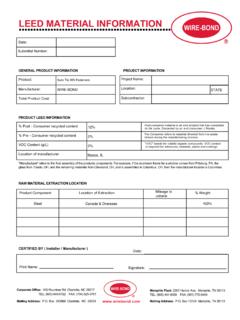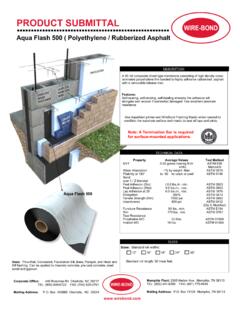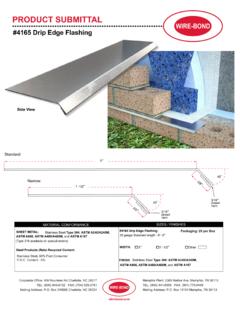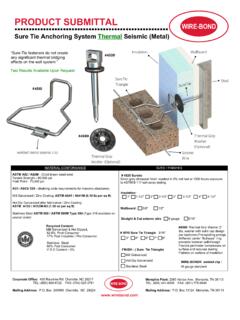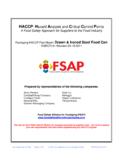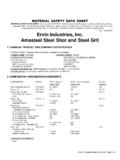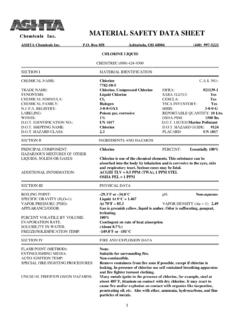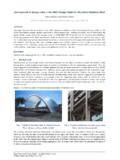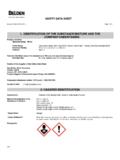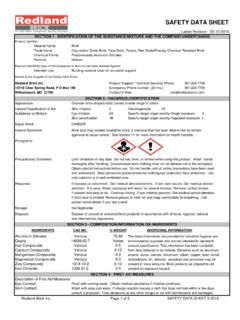Transcription of SAFETY DATA SHEET - wirebond.com
1 Page 1 of 14 SAFETY DATA SHEET 1. PRODUCT AND COMPANY IDENTIFICATION Product Name: GALVANIZED steel WIRE Synonyms: N/A CAS Number: MIXTURE Product Use: Various wire products. Manufacturer/Supplier: WIRE-BOND Address: 400 Rountree Road Charlotte, NC 28217 General Information: 704-525-5554 Transportation Emergency Number: CHEMTREC: 800-424-9300 2. HAZARDS IDENTIFICATION: This product is gray-black with no odor. Emergency Overview: steel Products sold by Mid South Wire are not hazardous per OSHA GHS 29 CFR 1910, 1915, 1926. However, individual customer processes (such as welding, sawing, brazing, grinding, abrasive blasting, and machining) may result in the formation of fumes, dust (combustible or otherwise), and/or particulate that may present the following hazards: OSHA Hazards: Carcinogen Skin Sensitizer Target Organ Effect-Lungs WIRE-BONDPage 2 of 14 Classification: Carcinogenicity (Category 2) Skin Sensitization (Category 1) Specific Target Organ Toxicity-Repeated Exposure (Category 1) Pictogram(s).
2 Signal Word: Danger Hazard Statement(s) Dust/Fumes may cause an allergic skin reaction. Dust/Fumes suspected of causing cancer via inhalation. Inhalation of dust/fumes causes damage to respiratory tract through prolonged or repeated exposure. Precautionary Statement(s) Do not handle until all SAFETY precautions have been read and understood. Avoid breathing dust/fumes. Use personal protective equipment as required. If exposed or concerned: Get medical advice/attention. 3. COMPOSITION/INFORMATION The components listed below represent the chemical composition of the wire material: WIRE-BONDPage 3 of 14 steel Wire Composition Element CAS NO.
3 Wt. % OSHA PEL ACGIH-TLV Iron 7439-89-6 BALANCE 10MG/M3 5MG/M3 Manganese 7439-96-5 5MG/M3 5MG/M3 Silicon 7440-21-3 10MG/M3 10MG/M3 Chromium 7440-47-3 10MG/M3 5MG/M3 Molybdenum 7439-98-7 5MG/M3 5MG/M3 Carbon 7440-44-0 Non-Listed Nickel 7440-02-0 10MG/M3 5MG/M3 Sulfur 7704-34-9 N/AV N/AV Tin 7440-31-5 N/AV N/AV Phosphorus 7723-14-0 N/AV Copper 7440-50-8 Aluminum 7429-90-5 < N/AV 10MG/M3 Vanadium 7440-62-2 6MG/M3 Titanium 7440-32-6 < N/AV N/AV Boron 7440-42-8 < N/AV Lead 7439-92-1 < 10MG/M3 10MG/M3 No other elements or compounds exceed 1% N/AV=Not Available Surface Coating Element CAS NO.
4 Wt. % OSHA PEL ACGIH-TLV Zinc 7440-66-6 0-14* 5MG/M3 5MG/M3 Lead 7439-92-1 WIRE-BONDPage 4 of 14 Boron Salts 1303-96-4 N/A N/A Stearates N/A N/A 10MG/M3 Calcium Hydroxide 1305-62-0 N/A 10MG/M3 Zinc Oxide 1314-13-2 N/A 10MG/M3 Petroleum Dist. 8002-05-9 N/A 5MG/M3 Paraffinic Dist. 64742-65-0 N/A 5MG/M3 *See Zinc Table on Page 13 4. FIRST AID MEASURES Description of First Aid Measures Eye Contact: In case of overexposure to dusts or fumes, immediately flush eyes with plenty of water for at least 15 minutes, occasionally lifting the eye lids. Get medical attention if irritation persists. Thermal burns should be treated as medical emergencies.
5 Skin Contact: In case of overexposure to dusts or particulates, wash with soap and plenty of water. Get medical attention if irritation develops or persists. If thermal burn occurs, flush area with cold water and get immediate medical attention. Inhalation: In case of overexposure to dusts or fumes, remove to fresh air. Get immediate medical attention if symptoms described in the SDS develop. Ingestion: Not considered an ingestion hazard. However, if excessive amounts of dust or particulates are swallowed, treat symptomatically and supportively. Get medical attention. Notes to Physician: Inhalation of metal fume or metal oxides may produce an acute febrile state, with cough, chills, weakness, and general malaise, nausea, vomiting, muscle cramps, and remarkable WIRE-BONDPage 5 of 14 leukocytosis.
6 Treatment is symptomatic, and condition is self-limited in 24-48 hours. Chronic exposure to dusts may result in pneumoconiosis of mixed type. 5. FIRE FIGHTING MEASURES Flash Point (Method): Not applicable. Flammable Limits (% volume in air): Not applicable. Auto Ignition Temperature: Not applicable. Extinguishing Media: For molten metal, use dry powder or sand. For steel dust use dry sand, water, foam, argon or nitrogen. Special Fire Fighting Procedures: Do not use water on molten metal. Do not use Carbon Dioxide (CO2). Firefighters should not enter confined spaces without wearing NIOSH/MSHA approved positive pressure breathing apparatus (SCBA) with full face mask and full protective equipment.
7 Unusual Fire or Explosion Hazards: steel products doo not present fire or explosion hazards under normal conditions. Any non-oxidized fine metal particles/dust generated by grinding, sawing, abrasive blasting, or individual customer processes may produce materials that the customer should test for combustibility and other hazards in accordance with the applicable regulations. High concentrations of combustible metallic fines in the air may present an explosion hazard. 6. ACCIDENTAL RELEASE MEASURES Precautions if Material is Spilled or Released: Emergency response is unlikely unless in the form of combustible dust.
8 Avoid inhalation, eye, or skin contact of dusts by using appropriate precautions outlined in this SDS (see section 8). Fine turnings and small chips should be swept or vacuumed and placed into appropriate disposable containers. Keep fine dust or powder away from sources of ignition. Scrap should be reclaimed for recycling. Prevent materials from entering drains, WIRE-BONDPage 6 of 14 sewers, or waterways. Specific standards and regulations may be applicable to materials generated by individual customer processes. As appropriate, these standards and regulations should be consulted for applicability. Fire and Explosion Hazards: Some customer processes may generate combustible dust that may require specific precautions when cleaning spills or releases of dust.
9 Environmental Precautions: Some grades of steel may contain reportable quantities of alloying elements. See Section 15 for additional information. Waste Disposal Methods: Dispose of used or unused product in accordance with applicable Federal, State, and local regulations. Please recycle. 7. HANDLING AND STORAGE Storage Temperatures: Stable under normal temperatures and pressures. Precautions to be taken in Handling and Storing: Store away from strong oxidizers. Dusts and/or powders, alone, or combined with process specific fluids, may form explosive mixtures with air. Applicable Federal, state and local laws and regulations may require testing dust generated from processing of steel products to determine if it represents a fire or explosion hazard and to determine appropriate protection methods.
10 Avoid breathing dust or fumes. 8. EXPOSURE CONTROLS/PERSONAL PROTECTION Operations with potential for generating high concentrations of airborne particulates or fumes should be evaluated and controlled as necessary. Eye Protection: Use SAFETY glasses. Dust resistant SAFETY goggles are recommended under circumstances where particles could cause mechanical injury such as grinding or cutting. Face shields should be used when welding or cutting. WIRE-BONDPage 7 of 14 Skin: Appropriate protective gloves should be worn as necessary. Good personal hygiene practices should be followed including cleansing exposed skin several times daily with soap and water and laundering or dry cleaning soiled work clothing.

